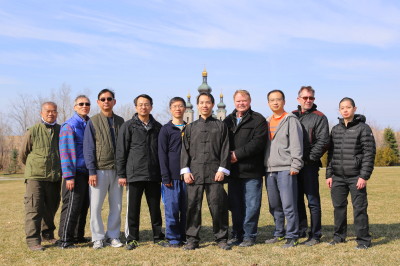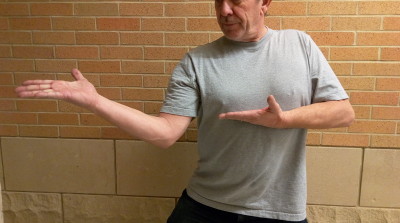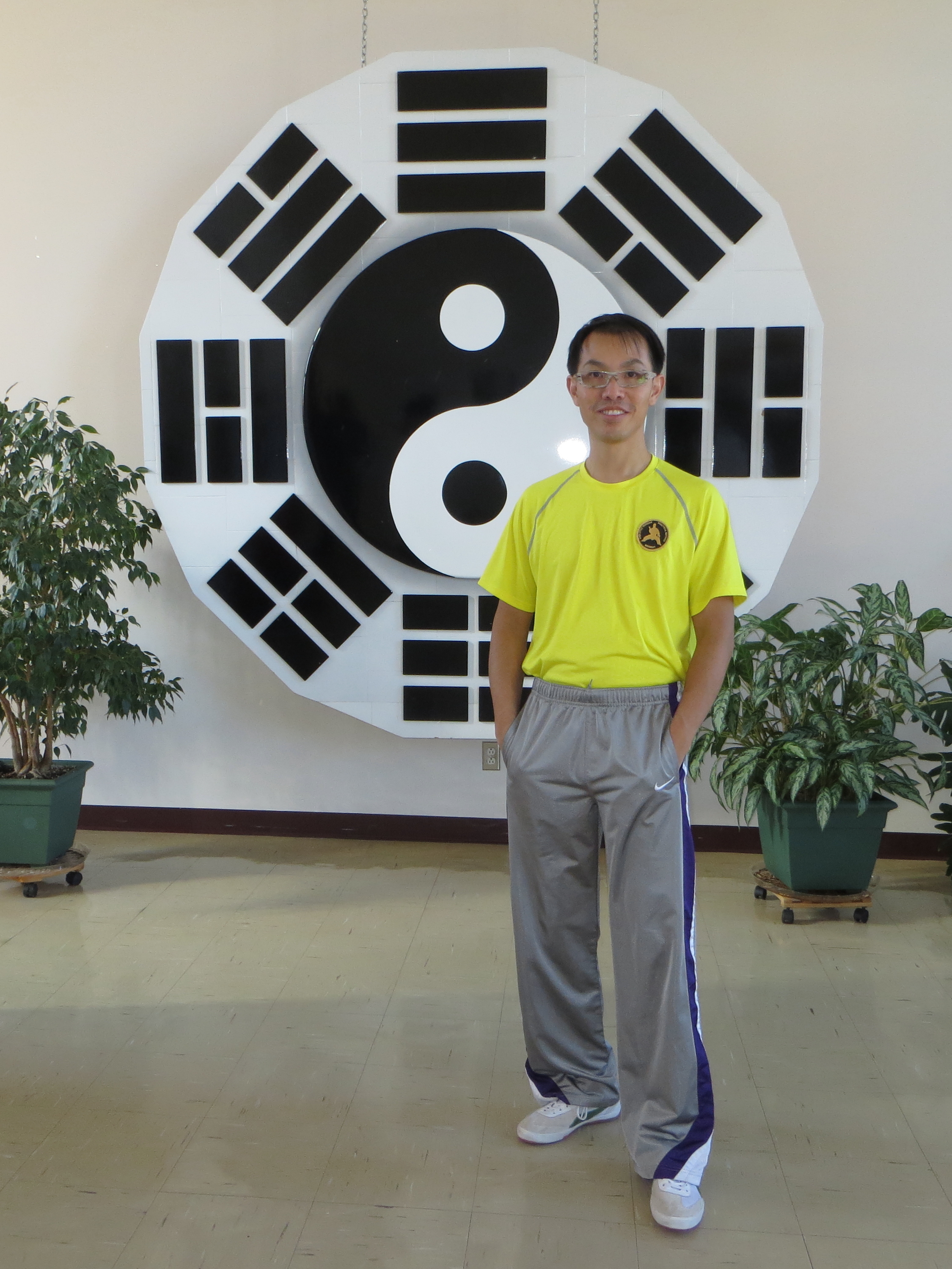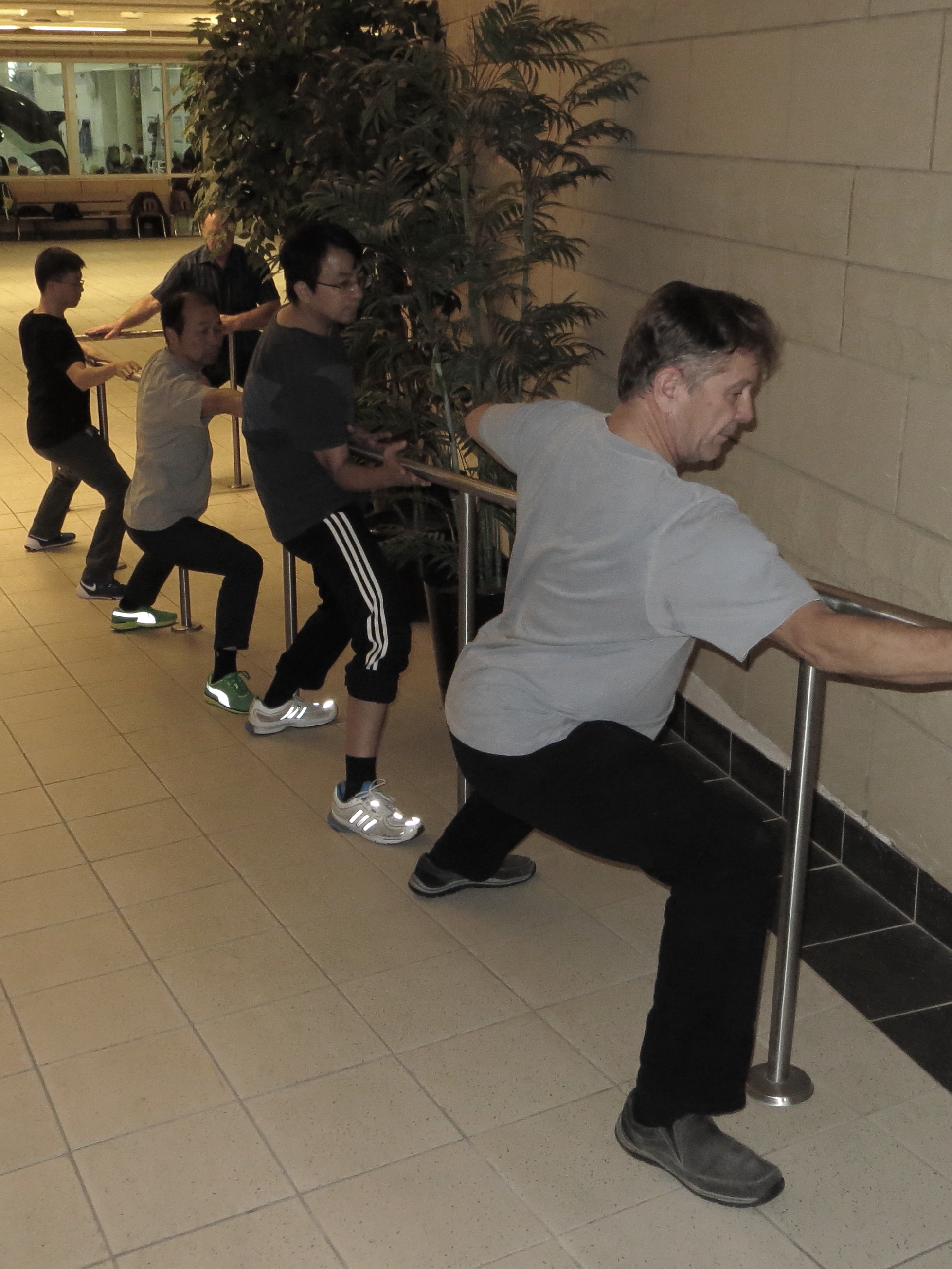
Left to Right:Dominic Lo, Ken Fong, Eric Foo, Kevin Sun, Lucas Lu, Kelvin Ho, Bruce Robinson, Peter Li, Mark Hanley, Patrick Kuo
Read more
Chen Zhonghua Taiji Academy Phone: 780-413-0454
Chen Taiji Practical Method and Hunyuan Taiji practical_method@outlook.com
by Kelvin Ho on 2017/04/09

Left to Right:Dominic Lo, Ken Fong, Eric Foo, Kevin Sun, Lucas Lu, Kelvin Ho, Bruce Robinson, Peter Li, Mark Hanley, Patrick Kuo
by Kelvin Ho on 2017/04/02

Location: Vine Cliff Park – Vine Cliff Blvd and Hazelton Ave.
Date: Apr 9, 2017
Time: 8 am – 10:30 am
Instructor: Kelvin Ho
Fee: Free and open to public
If it rains that day, the event location will be moved to:
Bayview Hill Community Centre (open area near the pool)
114 Spadina Rd, Richmond Hill, ON L4B 2Y9
This open class is an event to pre-celebrate World Taiji Day, which will be on Apr 29, 2017. It welcomes anyone interested in learning tai chi. It will let participants experience a typical class, which includes foundations, form and push hands.
See you there!
Registration is recommended, please contact Kelvin Ho by emailing kelvin.ho@practicalmethod.ca or texting 647-738-8384.
by Mark Hanley on 2017/04/01
fetching water,
– you must be in front bow stance with weight on front
– back hand open on belly
– front arm down open hand to thigh
– move front KWA out as the only movement – when front arm moves bring elbow to body
Kelvin ho had us doing this foundation exercise today. Issues I had around the move that I experienced
1. Moving shoulders ( I needed to press down first, move the kwa and capture the internal movement to go across my belly rather than up to my back shoulder)
Kelvin indicated that once stretched I should hold it for a minute or two to help loosen the kwa.
2. Moving front hands and arms independently ( the kwa works like a lever attached to the rope and pail gathering well water; when the rope moves back and forth so does the pail) the hands and arm cannot move independently
3. stance too high , I needed to perform the above in a lower stance
by Suz on 2017/03/31
Watching the teacher during practice sessions
In the beginning I used to observer my teacher’s external form. Where is his hands, the right or left moves first, what’s the next move, how high is his hands. Then I learned to observe beyond the physical form. Where is the weight, his focus, which parts of his body he is locking and releasing, path of movement and connection, parts that are strong and relaxed. How the weight is counterbalanced with hands out stretched, or leaning forward/backward.
Then Self-reflection and assessment is key. Understanding how the body works and moves. Physical appearance: grounding, stretching out, grounding more while expending to maintain balance.
Why we shift weight and settle into posture by dropping weight. – My observation of my teacher- dropping weight grounds the body and creates effectiveness. I.e. stepping into opponent’s space- weight forward – settling into pose, structure and weight drop to create effectiveness.
by Suz on 2017/03/31
Toronto North York Taiji Class on March 30, 2017
3 steps
Half horse stance posture
Bring right hand 45 degree palm up – Just above the left thigh
Bring left hand near right hand 45 degree palm up, elbows touching in a straight line Pull elbows to dantian at the same time bringing left foot (with toes) in beside the right foot. Rest the heel of the foot. All should be one action, like a bullet.
Things to check.
by Mark Hanley on 2017/03/27
Review of Positive circle
-elbow in do not move hand or wrist
– twist waist without moving hips
– hand out do not move elbow
– do not move off the finger line to the exact spot on the opponent
starting in front bow stance after bringing in my elbow, I found that when I twisted my waist my weight moved off the front foot. Kelvin Ho corrected this by calling out when my weight incorrectly changed from my front foot. The twisting of the waist helps bring the elbow to the centerline. It requires a lot of focus to keep the fingers leading when going out torqueing the arm while not letting the elbow get away and keeping it down.
by Kelvin Ho on 2017/03/26
Kelvin Ho was invited to perform taijiquan during multi-cultural week at Sir Wilfrid Laurier Public School on Mar. 23, 2017.
by Bruce Robinson on 2017/03/26
by adriennesoles on 2017/03/19
1) Today we practiced not moving the knee forward during movements involving steping forward. Think of “stretching” hamstring and calf muscle as if knee pushing those 2 points apart (like a triangle )
Corrections in first movement when arms leads out to right after foot shovels forward-should be a positive circle leading with hand.
Also in first move as arms sweeps through to front, lead with elbow and don’t let arm or elbow drop lower.
In second movement correction was to make sure I never see my palm. Don’t turn wrist.
2) White Crane Spreads its Wings
by Mark Hanley on 2017/03/06
Last week Kelvin Ho review turning flower out at bottom of sea. he posted a video and the following points
1) Maintain a non-moving vertical rod from head to left heel throughout the action.
2) Hold the right forearm in front of the chest with a fist, while the left fist is on the side of the body.
3) Throw the right fist down to the right side as hard as possible with a raising right knee to create a scissoring effect, while throwing the left fist up to the left ear.
4) There should be no tossing or turning of the body, but there is a spiral stretch along the vertical rod Read more
by Kelvin Ho on 2017/03/04
We worked on a few different moves in the form today. The first 3 moves required standing on one leg.
by Kelvin Ho on 2017/03/04
by Kelvin Ho on 2017/03/03
by Kelvin Ho on 2017/03/01

by Kelvin Ho on 2017/02/25
1) Maintain a non-moving vertical rod from head to left heel throughout the action.
2) Hold the right forearm in front of the chest with a fist, while the left fist is on the side of the body.
3) Throw the right fist down to the right side as hard as possible with a raising right knee to create a scissoring effect, while throwing the left fist up to the left ear.
4) There should be no tossing or turning of the body, but there is a spiral stretch along the vertical rod.
by Suz on 2017/02/06
Twisting towel – Ning maogin
Straight torso – spine stretched – legs apart –bend knees a bit just to make upside down U shape … Imagine there is a horizontal bar just below navel area, stretched forward and vertical rod from head to ground
Fingers always stretched and slightly open, except the thumb, thumb touching forefinger. Arms at navel level, stretch forward tucking elbow towards the center of your body- keeping wrist locked (wrist doesn’t movie) elbow straight – shoulders locked (moving only within its socket)
by adriennesoles on 2017/02/05
Position of elbow in positive circle: After warming up with what we learned the last 2 weeks, we reviewed the line that the elbow follows in first move of Positive Circle. It should follow a straight line as if it’s in a track. Fingers should still point at same spot. We tried looking at the line the forearm was making in mirror.
To finish positive circle after turning at waist, lead with hand as if forearm is in a tube and sliding out sequentially. Don’t let forearm deviate outwards as it wants to.
Buddha’s Warrior Pounds Mortar:
Read more
by admin2 on 2017/02/01
By Patrick Hanratty
**Due to my computer crashing these notes have been recompiled using my original written notes, which are somewhat incomplete. As such there are some blank spaces, which I’ve indicated with an asterisk. I would very much appreciate anyone filling in those blanks, as I don’t feel confident enough to do so myself.
Taking notes at workshops is a useful tool for making progress, and going over them as soon as possible (at the end of the day and after the workshop) helps to internalize the most salient points. Furthermore, sharing notes, as well as potentially helping other students in their practice, can also engender a need for the note taker to test the accuracy of their personal understanding of Master Chen’s teaching. A testing strategy that I have recently adopted is to imagine that I have to explain my understanding to other students through practical demonstration. Read more
by Mark Hanley on 2017/01/30
Hand starts and 45 degrees and ends at 45 degrees, s the elbow comes to centerline. The energy must come from the foot to the hand. This Is much more difficult then it seems. The tendency for me was to bend the wrist independent from the arm and to move the arm out with no regard for the line. I found it very helpful to stand on a tiled floor which allowed me to better concentrate on the line. By doing this I found that the line allowed me to better keep arm on the line and my wrist better alignment with the rest of the arm.
by Mark Hanley on 2017/01/30
start in front bow stance , back arm bent palm up front arm bent also palm up, this creates a line, bring hip and shoulder to hand line, be sure hip is up and out, shoulder is down and out, front elbow twists in as action performed. Back also straitens and ass is not out. Do not move wrist independently. I found that I could better concentrate and get more consistent results by starting with the front elbow touching my side. Taking pictures of yourself is also good idea because you see what you do wrong I have started to practise in the mirror so I can see and correct things like raising my back shoulder
by Mark Hanley on 2017/01/30
IN fetching water, you must be in front bow stance. back arm bent palm up front arm down front kwa hand open, First internally connect front hip to back shoulder around and down to back hip somewhat like suspenders. This little effort to start really helps. Then open front hip moving it to the line. As that happens notice front shoulder goes down twist in the front elbow.
by Bruce Robinson on 2017/01/28
Kelvin Ho went over the 3 of the main foundation exercise movements today, twisting the towel, Fetch Water & Six Sealing four Closing
Twisting the Towel:
by Kelvin Ho on 2017/01/27
by Kelvin Ho on 2017/01/22
Today, we focused on the details of 3 foundation exercises:
by Suz on 2017/01/19
Positive circle
Lower body
Legs apart – toes aligned with the other foot heel – foot open 45% outward and the other feet, toes close inward a bit – leaning closer to the front foot – Knee 90% measured at the ankle
Eyes
Choose a focus point and keep your eyes pinned to the focus point always
Upper body and movement
Shoulder and wrist locked- fingers stretched – index finger pointing towards your focus point and not above your eyebrow – start with palm down pointing towards the ground- bring elbow to right ribcage from waist twist all the way inside without losing your focus point.
Repeat- in with elbow – turn with waist – out with hand. Keep elbow bend all the time. Torso straight- knees turn up and down but not up and down.
45% in and out finger always pointing
Power comes from the heel
by Kelvin Ho on 2017/01/16
by Kelvin Ho on 2017/01/16
by Mark Hanley on 2017/01/14
Kelvin Ho gave us feedback on the first 7 moves of Yilu today. some examples to remember
Buddha’s warrior attendant pounds the mortar – in first move both arms move from the elbow. The right arm is a negative circle. Elbow is down and palm faces floor when you stretch out after grind out. To lift foot twist right elbow even more to connect and lift foot.
Block touching coat. – in step out adjust weight to front foot before arm moves and positive circle starts
Single whip – hands start at 45 degrees and end at 45 degrees as the elbow comes to centerline and fingers and forearm follow the same strait line rubbing against an imaginary vertical finger. The end of single whip the left hand out is a positive circle.
Brush knee – the left open hand drops down crossing knee. The end of brush knee when both arms are extended squeeze in on chest and down back as to not cause a rise in the chest. I found this very significant feedback because this is true in so many of the moves. It also seemed to have an impact on my next move to keep my back steady in initial closing.
Today I realized how significant independent practice is in this practical method. Your body needs time to adjust to perform proper alignment and stretches. If your elbow has limited mobility or you cannot convert the squeeze in the chest to the back and downward, you need practise before you can move forward with more constructive feedback.
Instructor Kelvin Ho worked through a number of items in today’s class today with me and Bruce Robinson.
All Movement – keep elbows pointed to the ground, open hand position and stretch through to fingers
Buddha’s warrior attendant pounds the mortar – start with right hand against chest as you turn hand releases from chest, front hand does not retreat. after ground out completes keep elbow pointing down as you stretch to fingers at end of stretch right elbow in.
Block touching coat – left hand is negative circle , right is positive circle. adjust lower body outward before starting positive circle.
White crane spread it’s wings – As part of stepping back adjust your back so that it is solid before moving the left leg back and raising and stretching the arms from the back outward to the finger tips. Easier said than done the idea of fixing the back against an imagery wall so that it does not move is very difficult. However by working with Kelvin today I can see what I am working toward.
by Kelvin Ho on 2017/01/06
In 2016, two Practical Method workshops were held in Toronto in January and September, with over 20 participants coming from Toronto and its surrounding cities, Ottawa, Montreal, New York, Michigan and as far away as California.
by Kelvin Ho on 2016/12/31
by Kelvin Ho on 2016/12/26
by Mark Hanley on 2016/12/15
The instruction is very simple elbow in turn the waist out with hand
I found that I had bent my wrist in Block touching coat and that I repeated this wrist turn in the positive circle. Kelvin helped me understand what I had done, after correction suggested I use a mirror at home to reinforce the elbow rotation without moving my wrist independently. I took this advice and found that It really helped.
So now I bring my elbow in, it rotates more easily by turning the waist and then the straighter arm always the hand to extend better
by Mark Hanley on 2016/12/15
The instruction is very simple sink kwa rotate elbow and open without using force. I found that I could sink the kwa easily but then turned to force to open the grip.
Kelvin helped me first by holding my arms but then changed the grip to using a single finger against my arm instead of holding the arm. He indicated that I should warp around the finger. This helped, I found that after I sank by stretching my fingers and wrist open it allowed me to get a better movement in my elbow which in turn allowed me to better wrap around the finger.
by Kelvin Ho on 2016/12/10
by Kelvin Ho on 2016/12/10
by Kelvin Ho on 2016/11/20

This is the first time I attended the Ottawa Workshop. Great group! Thanks Rachelle, James, and Daniel for organizing the workshop, and Rachelle for my stay at her place. Here are my notes:
by Kelvin Ho on 2016/11/19
At the Ottawa Nov. 12-13, 2016 workshop, Master Chen Zhonghua talked about when doing twisting the towel or six sealing four closing, our hands and elbows must stay on the same line. Where was that line exactly? We often just imagined where that line was. He told us to use a physical object to guide us, and he used a stick to show us. In today’s class in Toronto, we started with twisting the towel and covered what I learned at the Ottawa workshop. We went on to use the railing at the community centre to do the six sealing four closing exercise.


by Kelvin Ho on 2016/11/06
by admin2 on 2016/10/16
